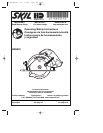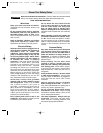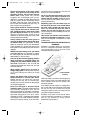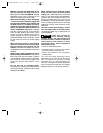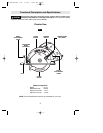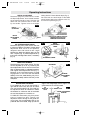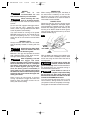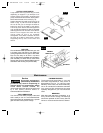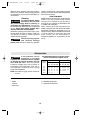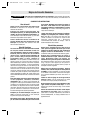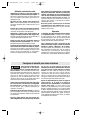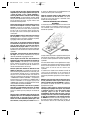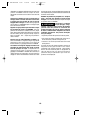
-4-
Check the operation of the lower guard
spring. If the guard and the spring are not
operating properly, they must be serviced
before use. Lower guard may operate
sluggishly due to damaged parts, gummy
deposits, or a buildup of debris. Disconnect the
plug from power source. Periodically remove
the blade, clean the upper, lower guards and
the hub area with kerosene and wipe it dry, or
blow it clean with compressed air.
Lower guard should be retracted manually
only for special cuts such as “Pocket Cuts”
and “Compound Cuts”. Raise lower guard
by Lower Guard Lift Lever. As soon as blade
enters the material, lower guard must be
released. For all other sawing, the lower guard
should operate automatically.
Always observe that the lower guard is
covering the blade before placing saw down
on bench or floor. An unprotected, coasting
blade will cause the saw to walk backwards,
cutting whatever is in its path. Be aware of the
time it takes for the blade to stop after switch is
released.
NEVER hold piece being cut in your hands
or across your leg. It is important to support
the work properly to minimize body exposure,
blade binding, or loss of control.
Hold tool by the insulated gripping surfaces
when performing an operation where the
cutting tool may contact hidden wiring or it
own cord. Contact with a "live" wire will also
make exposed metal parts of the tool “live” and
shock the operator.
When ripping always use a rip fence or
straight edge guide. This improves accuracy
of cut and reduces the chance for blade
binding.
Always use blades with correct size and
shape (diamond vs. round) arbor holes.
Blades that do not match the mounting
hardware of the saw will run eccentrically,
causing loss of control and will not allow proper
vari-torque engagement.
Never use damaged or incorrect blade
washers or bolts. The blade washers and bolt
were specially designed for your saw, for
optimum performance and safety of operation.
The blade washers and the bolt on your saw
have been designed to work as a “VARI-
TORQUE CLUTCH”. Understand the operation
and settings of the VARI-TORQUE CLUTCH,
because the proper setting of the CLUTCH,
combined with firm handling of the saw will
allow you to control KICKBACK.
Do not run the saw while carrying it at your
side. Lower guard may be opened by a
contact with your clothing. Accidental contact
with the spinning saw blade could result in
serious personal injury.
Depending upon use, the switch may not
last the life of the saw. If the switch should
fail in the “OFF” position, the saw may not
start. If it should fail while the saw is
running, the saw may not shut off. If either
occurs, unplug the saw immediately and do not
use until repaired.
This circular saw should not be mounted to
a table and converted to a table saw. Circular
saws are not designed or intended to be used
as table saws.
CAUSES AND OPERATOR PREVENTION OF
KICKBACK:
Kickback is a sudden reaction to a pinched,
bound or misaligned saw blade, causing an
uncontrolled saw to lift up and out of the
workpiece toward the operator.
When the blade is pinched or bound tightly by
the kerf closing down, the blade stalls and the
motor reaction drives the unit rapidly back
toward the operator.
If the blade becomes twisted or misaligned in
the cut, the teeth at the back edge of the blade
can dig into the top surface of the wood
causing the blade to climb out of the kerf and
jump back toward the operator.
Kickback is the result of tool misuse and/or
incorrect operating procedures or conditions
and can be avoided by taking proper
precautions as given below:
VARI-TORQUE
CLUTCH
KICKBACK
SM 2610905556 1/03 1/9/03 11:24 AM Page 4



